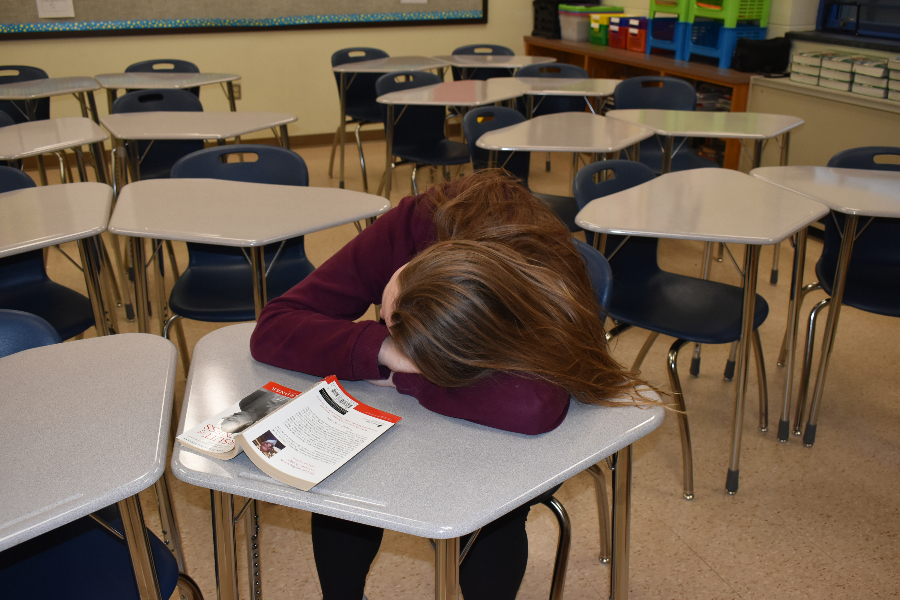Catching up on some ZZZZZs
Some schools and even jobs allow napping to improve concentration and work environment
Fatigue in school can come from poor choices at home, but there are other factors, as well.
January 2, 2020
It’s 11:30 and you’re playing a video game. You just started, and before you know it, it’s 12:00.
You know you should go to bed but you want to finish this game first. When you finally finish, it’s 12:30 a.m. You have to get up for school the next day but you wanna play another game, knowing you have to get up early.
This is a scenario much more common than many adults would believe.
Most teens don’t get enough sleep, which results in not being able to pay attention in school.
Students on average only get about 7.6 hours of sleep per night.
There are a lot of disadvantages to not getting enough sleep, such as limiting students’ ability to learn and concentrate, leading to acne and skin problems and aggressive behavior, and causing students to eat too much or eat unhealthy foods.
Not getting enough sleep every night can also affect students’ GPA and level of motivation.
So, if teens aren’t getting enough sleep at home, would having a nap during the school day help them concentrate better?
This has not been proposed or even discussed at Bellwood-Antis but in other areas, it has been a question up for debate.
“I think it’s a great idea if the student is sick or not sleeping well. I think it would help kids concentrate more, otherwise you have students falling asleep in class,” said B-A nurse Mrs. Hoover.
While Mrs. Hoover thinks it’s a good idea in concept, some B-A teachers do not.
“I think naps in school are ridiculous. Kids need to sleep at home and put down the video games. Naps during the day is inconsistent with the reality of most professions,” said civics teacher Mr. Matthew McNaul.
There are students who agree with Mr. McNaul.
“It wouldn’t help us concentrate because you are normally disoriented when you first wake up. When I don’t get enough sleep, I have trouble concentrating on my school work,” said 11th grader Charles Wachicki.
Some studies say that lack of sleep correlates with drinking, smoking, and drug use. Still, most B-A teachers don’t see a benefit of naps during the day.
“This is a strange idea. We are preparing students for the work force. Go to bed at a normal time and put away the social media,” said Media Center advisor Mr. Tim Texler. “It’s like a power nap that might make you feel better, but it’s not magic that makes students study and learn better.”
This may be true about most jobs, but the truth is some well-known companies have begun allowing their employees to take naps whenever they feel necessary. For example, the Google headquarters has EnergyPods created by MetroNaps. EnergyPods are sleeping bubbles with music to help you sleep. Another big company that allows naps is the Nike headquarters. Their employees have access to quiet rooms where they can meditate or catch a nap anytime they’d like.
If teens are driving to school on 2-5 hours of sleep, there is a big possibility that they could fall asleep behind the wheel, which is one more reason why naps could be beneficial, particularly for those driving home after school.
“Students should be allowed to sleep. Your grades are up to you, and if you want to nap during class you should be able to,” said junior Brendan Andrews.
Contrary to popular belief, it’s not only video games that keep teens from sleep. Some teens have stressful home environments, which leads them to not getting enough sleep. Another study shows that at least once a week, more than 28% of students fall asleep in school, 22% fall asleep doing homework, and 14% arrive late or miss school because they oversleep.
Some high schools are starting to take notice of the increased need for student sleep. La Cruz high school in New Mexico has made special sleep areas for their students to take naps in. Other schools are looking into letting their students nap during school.
But for many teachers, the key is promoting overall better sleep habits and not fostering poor sleep habits by allowing naps.
“Some students are nappers and some are not. I don’t think we would see an improvement because students will be more tired after they wake up from a nap. They would not be able to concentrate because they would still be trying to wake up from the nap and focus,” said middle school teacher Mrs. Susan Nycum.






